Analysis of Manufacturing Systems: KPIs, Layouts, and Improvement
VerifiedAdded on 2023/04/21
|22
|5934
|142
Report
AI Summary
This report provides a comprehensive analysis of manufacturing systems, focusing on key performance indicators (KPIs) and their role in addressing competitiveness issues. It explores approaches for establishing performance measures at the shop floor level, including heuristic and linear programming models, and explains how these measures contribute to achieving corporate objectives. The report also details product flow analysis (PFA) and value stream mapping (VSM), illustrating their uses in manufacturing companies to optimize processes. Different types of plant layouts are described, along with their benefits related to production varieties, volume, and economies of scale. Furthermore, the document includes a critical review of tools and techniques for process improvement within lean manufacturing systems, and defines various acronyms commonly used in the field, such as CNC, CAD, BOM, and ERP. The report also contains a case study on performance assessment of a manufacturing plant.

Running head: MANUFACTURING SYSTEMS
Manufacturing Systems
Name of the Student
Name of the University
Author’s Note:
Manufacturing Systems
Name of the Student
Name of the University
Author’s Note:
Paraphrase This Document
Need a fresh take? Get an instant paraphrase of this document with our AI Paraphraser
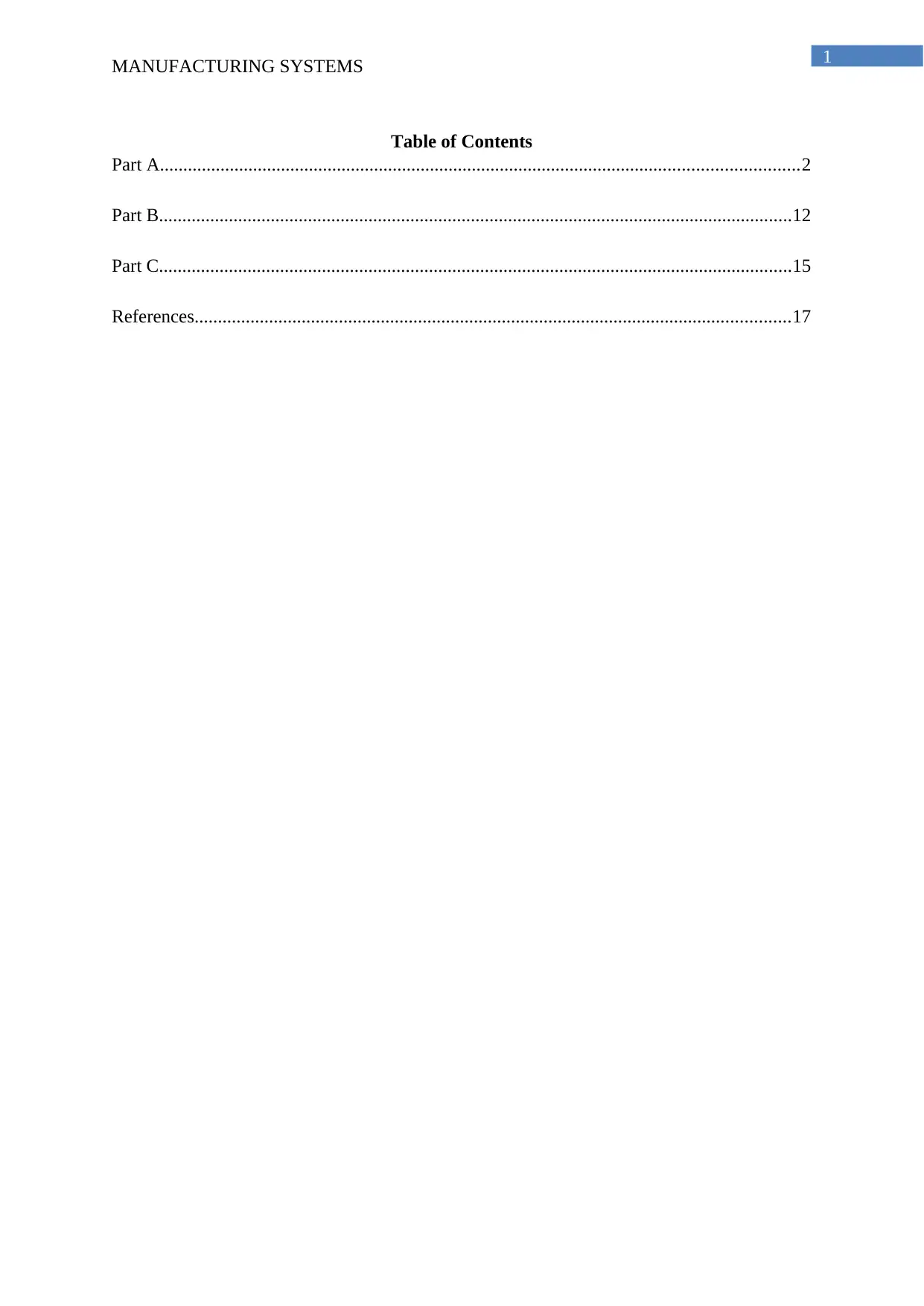
1
MANUFACTURING SYSTEMS
Table of Contents
Part A.........................................................................................................................................2
Part B........................................................................................................................................12
Part C........................................................................................................................................15
References................................................................................................................................17
MANUFACTURING SYSTEMS
Table of Contents
Part A.........................................................................................................................................2
Part B........................................................................................................................................12
Part C........................................................................................................................................15
References................................................................................................................................17
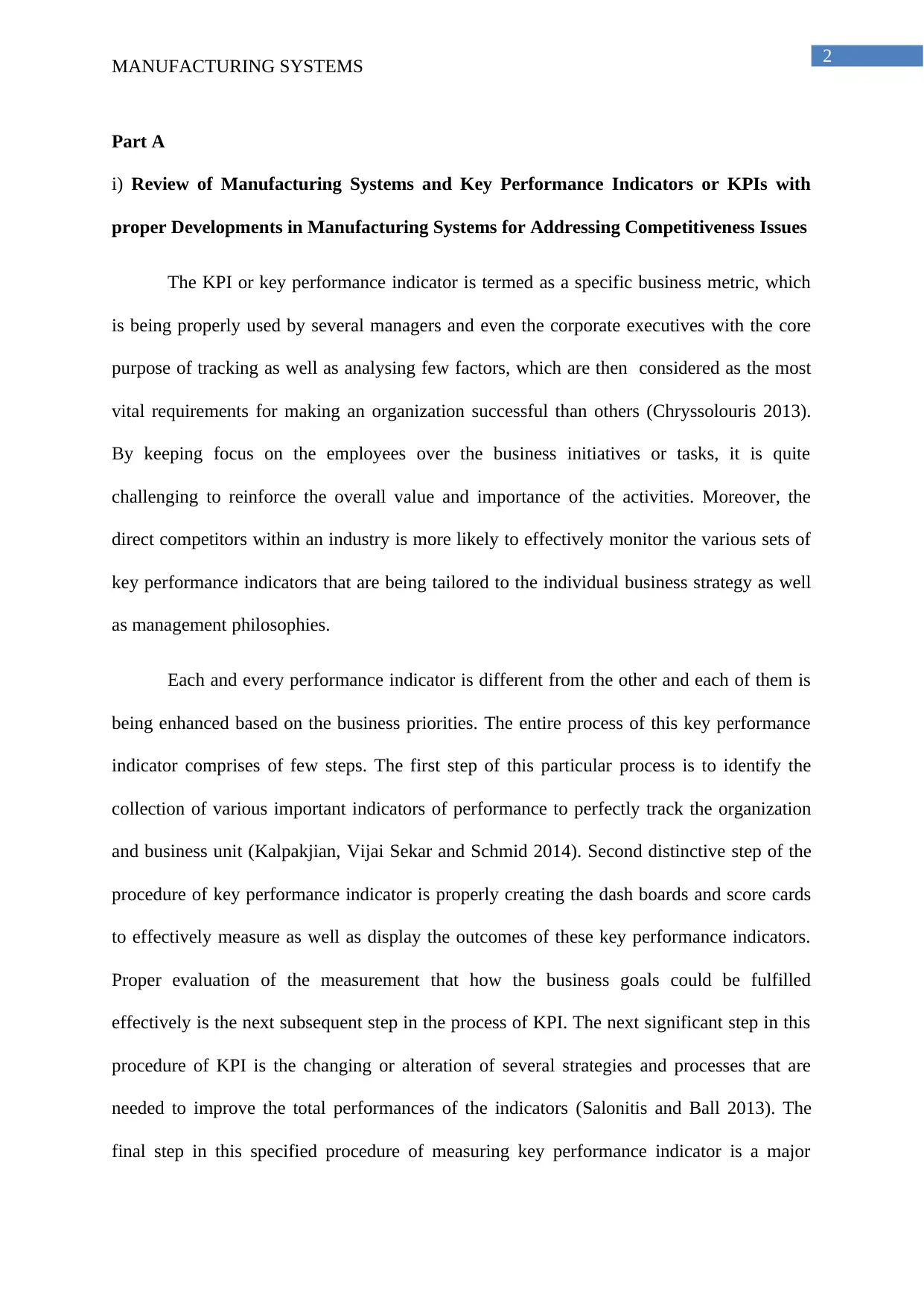
2
MANUFACTURING SYSTEMS
Part A
i) Review of Manufacturing Systems and Key Performance Indicators or KPIs with
proper Developments in Manufacturing Systems for Addressing Competitiveness Issues
The KPI or key performance indicator is termed as a specific business metric, which
is being properly used by several managers and even the corporate executives with the core
purpose of tracking as well as analysing few factors, which are then considered as the most
vital requirements for making an organization successful than others (Chryssolouris 2013).
By keeping focus on the employees over the business initiatives or tasks, it is quite
challenging to reinforce the overall value and importance of the activities. Moreover, the
direct competitors within an industry is more likely to effectively monitor the various sets of
key performance indicators that are being tailored to the individual business strategy as well
as management philosophies.
Each and every performance indicator is different from the other and each of them is
being enhanced based on the business priorities. The entire process of this key performance
indicator comprises of few steps. The first step of this particular process is to identify the
collection of various important indicators of performance to perfectly track the organization
and business unit (Kalpakjian, Vijai Sekar and Schmid 2014). Second distinctive step of the
procedure of key performance indicator is properly creating the dash boards and score cards
to effectively measure as well as display the outcomes of these key performance indicators.
Proper evaluation of the measurement that how the business goals could be fulfilled
effectively is the next subsequent step in the process of KPI. The next significant step in this
procedure of KPI is the changing or alteration of several strategies and processes that are
needed to improve the total performances of the indicators (Salonitis and Ball 2013). The
final step in this specified procedure of measuring key performance indicator is a major
MANUFACTURING SYSTEMS
Part A
i) Review of Manufacturing Systems and Key Performance Indicators or KPIs with
proper Developments in Manufacturing Systems for Addressing Competitiveness Issues
The KPI or key performance indicator is termed as a specific business metric, which
is being properly used by several managers and even the corporate executives with the core
purpose of tracking as well as analysing few factors, which are then considered as the most
vital requirements for making an organization successful than others (Chryssolouris 2013).
By keeping focus on the employees over the business initiatives or tasks, it is quite
challenging to reinforce the overall value and importance of the activities. Moreover, the
direct competitors within an industry is more likely to effectively monitor the various sets of
key performance indicators that are being tailored to the individual business strategy as well
as management philosophies.
Each and every performance indicator is different from the other and each of them is
being enhanced based on the business priorities. The entire process of this key performance
indicator comprises of few steps. The first step of this particular process is to identify the
collection of various important indicators of performance to perfectly track the organization
and business unit (Kalpakjian, Vijai Sekar and Schmid 2014). Second distinctive step of the
procedure of key performance indicator is properly creating the dash boards and score cards
to effectively measure as well as display the outcomes of these key performance indicators.
Proper evaluation of the measurement that how the business goals could be fulfilled
effectively is the next subsequent step in the process of KPI. The next significant step in this
procedure of KPI is the changing or alteration of several strategies and processes that are
needed to improve the total performances of the indicators (Salonitis and Ball 2013). The
final step in this specified procedure of measuring key performance indicator is a major
⊘ This is a preview!⊘
Do you want full access?
Subscribe today to unlock all pages.

Trusted by 1+ million students worldwide
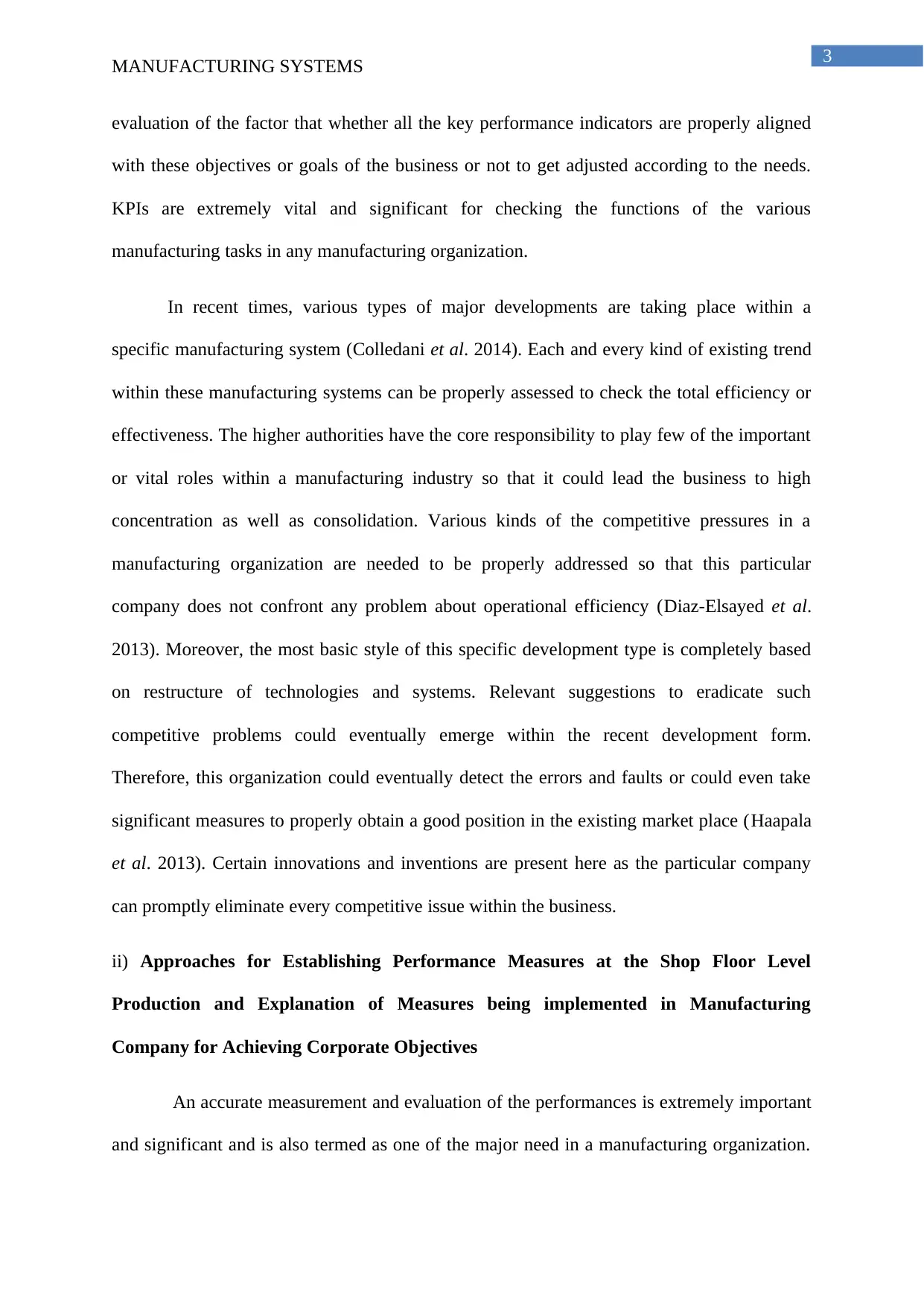
3
MANUFACTURING SYSTEMS
evaluation of the factor that whether all the key performance indicators are properly aligned
with these objectives or goals of the business or not to get adjusted according to the needs.
KPIs are extremely vital and significant for checking the functions of the various
manufacturing tasks in any manufacturing organization.
In recent times, various types of major developments are taking place within a
specific manufacturing system (Colledani et al. 2014). Each and every kind of existing trend
within these manufacturing systems can be properly assessed to check the total efficiency or
effectiveness. The higher authorities have the core responsibility to play few of the important
or vital roles within a manufacturing industry so that it could lead the business to high
concentration as well as consolidation. Various kinds of the competitive pressures in a
manufacturing organization are needed to be properly addressed so that this particular
company does not confront any problem about operational efficiency (Diaz-Elsayed et al.
2013). Moreover, the most basic style of this specific development type is completely based
on restructure of technologies and systems. Relevant suggestions to eradicate such
competitive problems could eventually emerge within the recent development form.
Therefore, this organization could eventually detect the errors and faults or could even take
significant measures to properly obtain a good position in the existing market place (Haapala
et al. 2013). Certain innovations and inventions are present here as the particular company
can promptly eliminate every competitive issue within the business.
ii) Approaches for Establishing Performance Measures at the Shop Floor Level
Production and Explanation of Measures being implemented in Manufacturing
Company for Achieving Corporate Objectives
An accurate measurement and evaluation of the performances is extremely important
and significant and is also termed as one of the major need in a manufacturing organization.
MANUFACTURING SYSTEMS
evaluation of the factor that whether all the key performance indicators are properly aligned
with these objectives or goals of the business or not to get adjusted according to the needs.
KPIs are extremely vital and significant for checking the functions of the various
manufacturing tasks in any manufacturing organization.
In recent times, various types of major developments are taking place within a
specific manufacturing system (Colledani et al. 2014). Each and every kind of existing trend
within these manufacturing systems can be properly assessed to check the total efficiency or
effectiveness. The higher authorities have the core responsibility to play few of the important
or vital roles within a manufacturing industry so that it could lead the business to high
concentration as well as consolidation. Various kinds of the competitive pressures in a
manufacturing organization are needed to be properly addressed so that this particular
company does not confront any problem about operational efficiency (Diaz-Elsayed et al.
2013). Moreover, the most basic style of this specific development type is completely based
on restructure of technologies and systems. Relevant suggestions to eradicate such
competitive problems could eventually emerge within the recent development form.
Therefore, this organization could eventually detect the errors and faults or could even take
significant measures to properly obtain a good position in the existing market place (Haapala
et al. 2013). Certain innovations and inventions are present here as the particular company
can promptly eliminate every competitive issue within the business.
ii) Approaches for Establishing Performance Measures at the Shop Floor Level
Production and Explanation of Measures being implemented in Manufacturing
Company for Achieving Corporate Objectives
An accurate measurement and evaluation of the performances is extremely important
and significant and is also termed as one of the major need in a manufacturing organization.
Paraphrase This Document
Need a fresh take? Get an instant paraphrase of this document with our AI Paraphraser
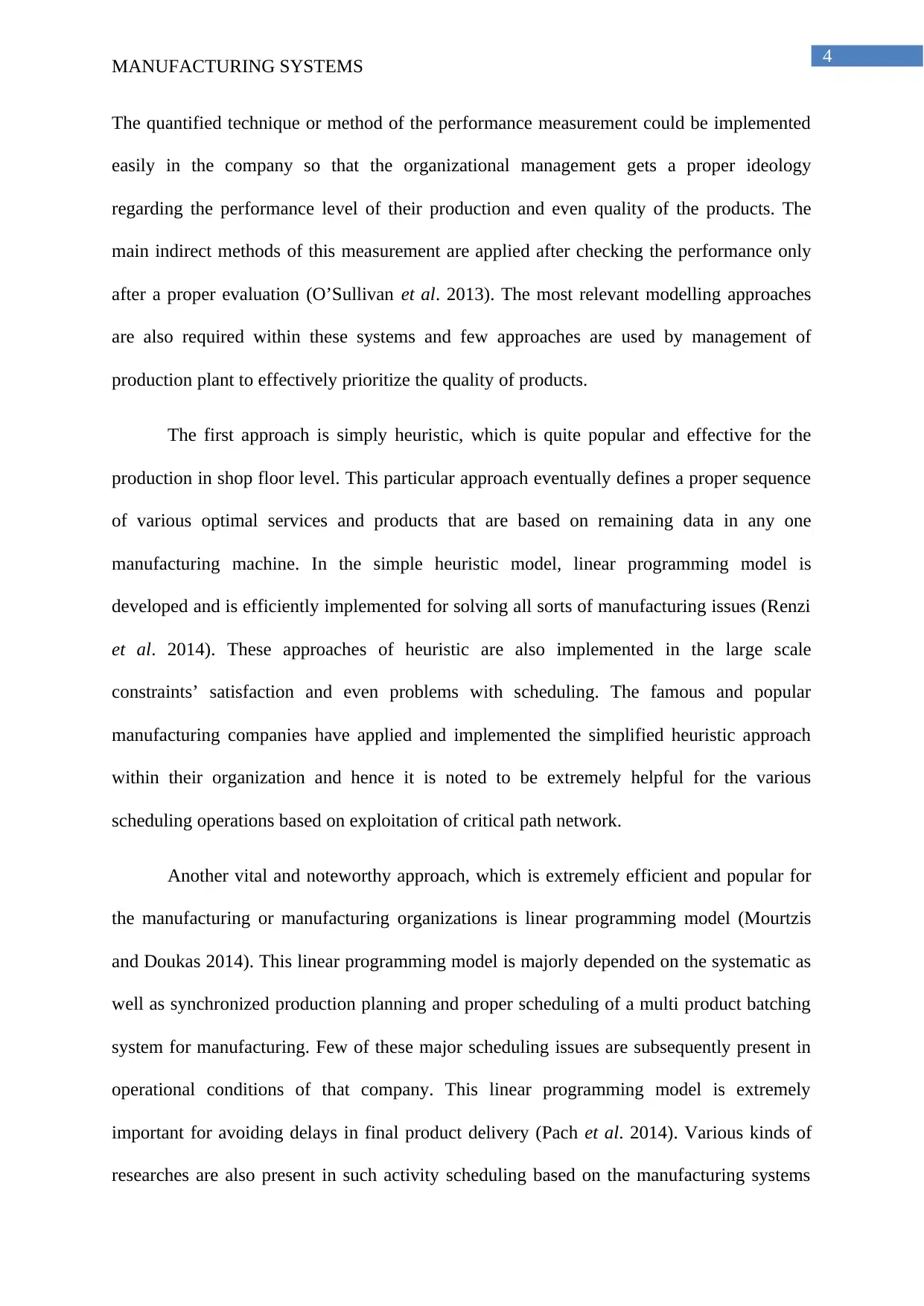
4
MANUFACTURING SYSTEMS
The quantified technique or method of the performance measurement could be implemented
easily in the company so that the organizational management gets a proper ideology
regarding the performance level of their production and even quality of the products. The
main indirect methods of this measurement are applied after checking the performance only
after a proper evaluation (O’Sullivan et al. 2013). The most relevant modelling approaches
are also required within these systems and few approaches are used by management of
production plant to effectively prioritize the quality of products.
The first approach is simply heuristic, which is quite popular and effective for the
production in shop floor level. This particular approach eventually defines a proper sequence
of various optimal services and products that are based on remaining data in any one
manufacturing machine. In the simple heuristic model, linear programming model is
developed and is efficiently implemented for solving all sorts of manufacturing issues (Renzi
et al. 2014). These approaches of heuristic are also implemented in the large scale
constraints’ satisfaction and even problems with scheduling. The famous and popular
manufacturing companies have applied and implemented the simplified heuristic approach
within their organization and hence it is noted to be extremely helpful for the various
scheduling operations based on exploitation of critical path network.
Another vital and noteworthy approach, which is extremely efficient and popular for
the manufacturing or manufacturing organizations is linear programming model (Mourtzis
and Doukas 2014). This linear programming model is majorly depended on the systematic as
well as synchronized production planning and proper scheduling of a multi product batching
system for manufacturing. Few of these major scheduling issues are subsequently present in
operational conditions of that company. This linear programming model is extremely
important for avoiding delays in final product delivery (Pach et al. 2014). Various kinds of
researches are also present in such activity scheduling based on the manufacturing systems
MANUFACTURING SYSTEMS
The quantified technique or method of the performance measurement could be implemented
easily in the company so that the organizational management gets a proper ideology
regarding the performance level of their production and even quality of the products. The
main indirect methods of this measurement are applied after checking the performance only
after a proper evaluation (O’Sullivan et al. 2013). The most relevant modelling approaches
are also required within these systems and few approaches are used by management of
production plant to effectively prioritize the quality of products.
The first approach is simply heuristic, which is quite popular and effective for the
production in shop floor level. This particular approach eventually defines a proper sequence
of various optimal services and products that are based on remaining data in any one
manufacturing machine. In the simple heuristic model, linear programming model is
developed and is efficiently implemented for solving all sorts of manufacturing issues (Renzi
et al. 2014). These approaches of heuristic are also implemented in the large scale
constraints’ satisfaction and even problems with scheduling. The famous and popular
manufacturing companies have applied and implemented the simplified heuristic approach
within their organization and hence it is noted to be extremely helpful for the various
scheduling operations based on exploitation of critical path network.
Another vital and noteworthy approach, which is extremely efficient and popular for
the manufacturing or manufacturing organizations is linear programming model (Mourtzis
and Doukas 2014). This linear programming model is majorly depended on the systematic as
well as synchronized production planning and proper scheduling of a multi product batching
system for manufacturing. Few of these major scheduling issues are subsequently present in
operational conditions of that company. This linear programming model is extremely
important for avoiding delays in final product delivery (Pach et al. 2014). Various kinds of
researches are also present in such activity scheduling based on the manufacturing systems

5
MANUFACTURING SYSTEMS
and they also include few important model developments. The model majorly emphasizes on
production, planning as well as inventory of every horizontal cost.
A proper form of these above provided approaches is present, which is quite efficient
for successful determination of all types of rising issues within the manufacturing systems.
The significant strategy by which better competitive advantages are being obtained must be
followed by this manufacturing company and also manage their business processes
(Brandimarte and Villa 2013). An efficient type of strategic planning could even be helpful
for the manufacturing company to adopt several dynamical and methodical processes to make
it extremely easy to eliminate the significant issues of the manufacturing system.
iii) Explanation of Product Flow Analysis and Value Stream Mapping with proper Uses
in Manufacturing Companies
A product flow analysis or simply PFA is being explained as one of the major and
important establishing methodology that is being used for properly transforming the complete
functional layouts to the respective product oriented or structured layouts in the
manufacturing organization (Keddis et al. 2013). The methodology of parts routing is used
within this product flow analysis or simply PFA based on the searching of all types of natural
clusters in the various work stations. This parts routing is also helpful for forming the major
production cells within the manufacturing system. The product flow analysis also helps to
complete the parts and thus forming the basic components in extremely lesser amount of
time. It is also possible for making the flow of material within the respective products highly
simplified as well as relevant in nature (Chang, Wu and Wu 2013). After a successful
deployment of product flow analysis in the manufacturing company, the specified system to
schedule is eventually present to majorly control the several periodical batches.
MANUFACTURING SYSTEMS
and they also include few important model developments. The model majorly emphasizes on
production, planning as well as inventory of every horizontal cost.
A proper form of these above provided approaches is present, which is quite efficient
for successful determination of all types of rising issues within the manufacturing systems.
The significant strategy by which better competitive advantages are being obtained must be
followed by this manufacturing company and also manage their business processes
(Brandimarte and Villa 2013). An efficient type of strategic planning could even be helpful
for the manufacturing company to adopt several dynamical and methodical processes to make
it extremely easy to eliminate the significant issues of the manufacturing system.
iii) Explanation of Product Flow Analysis and Value Stream Mapping with proper Uses
in Manufacturing Companies
A product flow analysis or simply PFA is being explained as one of the major and
important establishing methodology that is being used for properly transforming the complete
functional layouts to the respective product oriented or structured layouts in the
manufacturing organization (Keddis et al. 2013). The methodology of parts routing is used
within this product flow analysis or simply PFA based on the searching of all types of natural
clusters in the various work stations. This parts routing is also helpful for forming the major
production cells within the manufacturing system. The product flow analysis also helps to
complete the parts and thus forming the basic components in extremely lesser amount of
time. It is also possible for making the flow of material within the respective products highly
simplified as well as relevant in nature (Chang, Wu and Wu 2013). After a successful
deployment of product flow analysis in the manufacturing company, the specified system to
schedule is eventually present to majorly control the several periodical batches.
⊘ This is a preview!⊘
Do you want full access?
Subscribe today to unlock all pages.

Trusted by 1+ million students worldwide
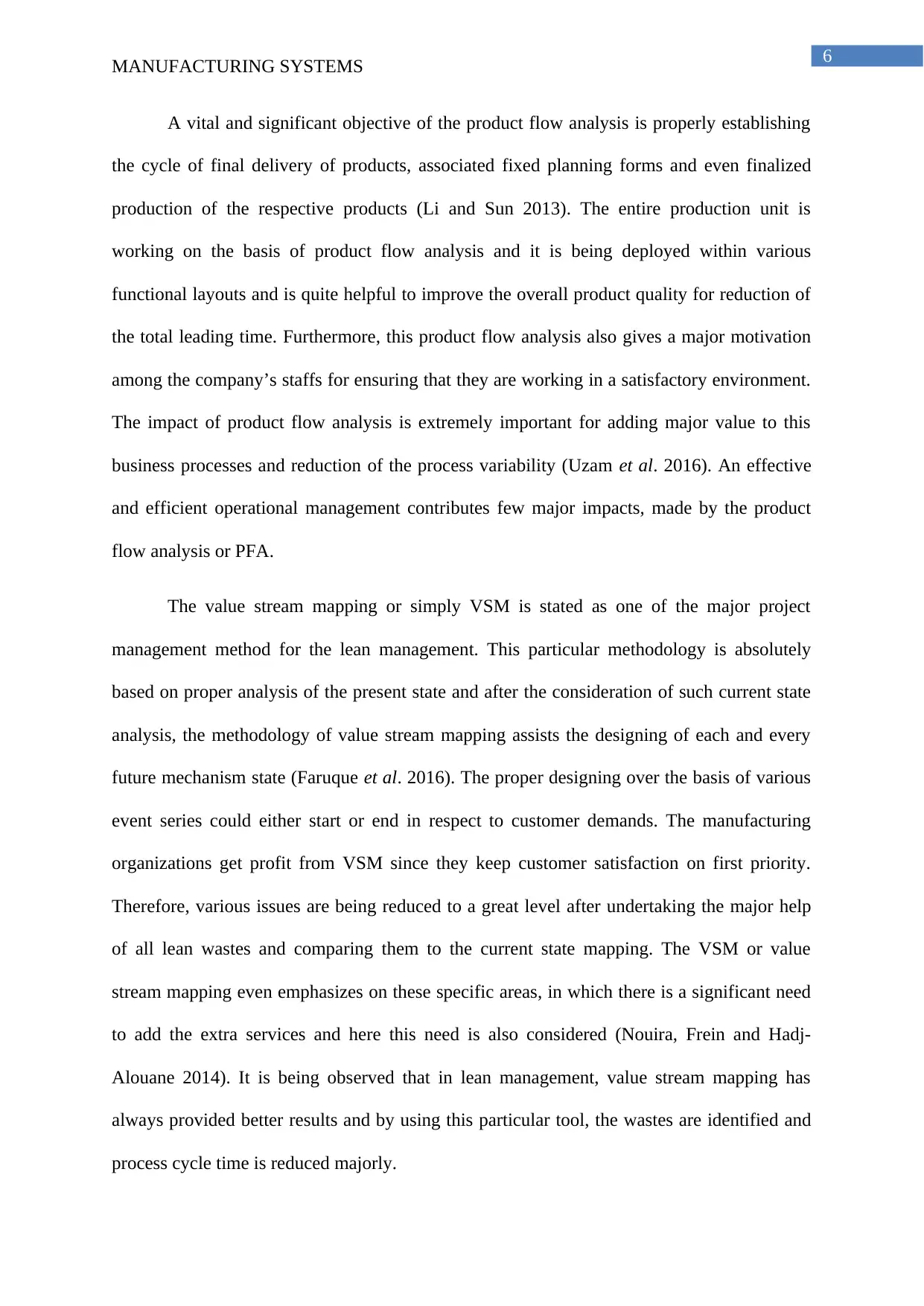
6
MANUFACTURING SYSTEMS
A vital and significant objective of the product flow analysis is properly establishing
the cycle of final delivery of products, associated fixed planning forms and even finalized
production of the respective products (Li and Sun 2013). The entire production unit is
working on the basis of product flow analysis and it is being deployed within various
functional layouts and is quite helpful to improve the overall product quality for reduction of
the total leading time. Furthermore, this product flow analysis also gives a major motivation
among the company’s staffs for ensuring that they are working in a satisfactory environment.
The impact of product flow analysis is extremely important for adding major value to this
business processes and reduction of the process variability (Uzam et al. 2016). An effective
and efficient operational management contributes few major impacts, made by the product
flow analysis or PFA.
The value stream mapping or simply VSM is stated as one of the major project
management method for the lean management. This particular methodology is absolutely
based on proper analysis of the present state and after the consideration of such current state
analysis, the methodology of value stream mapping assists the designing of each and every
future mechanism state (Faruque et al. 2016). The proper designing over the basis of various
event series could either start or end in respect to customer demands. The manufacturing
organizations get profit from VSM since they keep customer satisfaction on first priority.
Therefore, various issues are being reduced to a great level after undertaking the major help
of all lean wastes and comparing them to the current state mapping. The VSM or value
stream mapping even emphasizes on these specific areas, in which there is a significant need
to add the extra services and here this need is also considered (Nouira, Frein and Hadj-
Alouane 2014). It is being observed that in lean management, value stream mapping has
always provided better results and by using this particular tool, the wastes are identified and
process cycle time is reduced majorly.
MANUFACTURING SYSTEMS
A vital and significant objective of the product flow analysis is properly establishing
the cycle of final delivery of products, associated fixed planning forms and even finalized
production of the respective products (Li and Sun 2013). The entire production unit is
working on the basis of product flow analysis and it is being deployed within various
functional layouts and is quite helpful to improve the overall product quality for reduction of
the total leading time. Furthermore, this product flow analysis also gives a major motivation
among the company’s staffs for ensuring that they are working in a satisfactory environment.
The impact of product flow analysis is extremely important for adding major value to this
business processes and reduction of the process variability (Uzam et al. 2016). An effective
and efficient operational management contributes few major impacts, made by the product
flow analysis or PFA.
The value stream mapping or simply VSM is stated as one of the major project
management method for the lean management. This particular methodology is absolutely
based on proper analysis of the present state and after the consideration of such current state
analysis, the methodology of value stream mapping assists the designing of each and every
future mechanism state (Faruque et al. 2016). The proper designing over the basis of various
event series could either start or end in respect to customer demands. The manufacturing
organizations get profit from VSM since they keep customer satisfaction on first priority.
Therefore, various issues are being reduced to a great level after undertaking the major help
of all lean wastes and comparing them to the current state mapping. The VSM or value
stream mapping even emphasizes on these specific areas, in which there is a significant need
to add the extra services and here this need is also considered (Nouira, Frein and Hadj-
Alouane 2014). It is being observed that in lean management, value stream mapping has
always provided better results and by using this particular tool, the wastes are identified and
process cycle time is reduced majorly.
Paraphrase This Document
Need a fresh take? Get an instant paraphrase of this document with our AI Paraphraser

7
MANUFACTURING SYSTEMS
The subsequent using of the value stream mapping method within this manufacturing
organization is even helpful to introspect and improvise in a recent process state (Koren,
Wang and Gu 2017). The most important inputs to the value stream mapping could also
include each and every resource, which are present and are considered based on the leverage
of various produced services and goods.
The subsequent using of the product flow analysis within the manufacturing company
could be majorly aided by a machine based packaging. This could also take place by proper
formation of the larger sets of data that are needed to properly analyse (Efthymiou et al.
2014). This kind of specified analysis could be eventually conducted for the proper
adaptation of few outcomes in some of the significant situations. Moreover, such analysis is
also repeated within the other manufacturing companies without any skilled or trained
person.
iv) Description of Different Types of Plant Lay outs with Benefits relevant to Production
Varieties, Production Volume and Economies of Scale
The different types of plant lay outs that are completely relevant to the production
varieties, economies of scale and production volume with relevant details like advantages are
provided below:
i) Fixed Position Lay out: The first and the foremost important type of the plant
layout would be the fixed position lay out. An important or vital component is eventually
located in any particular fixed position; hence this name is given (Gu, Jin and Ni 2015). The
other significant equipment is then transferred to a specific location. The major and the
important benefit of the fixed position lay out majorly includes reducing the material
movements. Furthermore, capital investments are eventually reduced and few tasks are being
performed with much efficiency as per the business needs and expectations.
MANUFACTURING SYSTEMS
The subsequent using of the value stream mapping method within this manufacturing
organization is even helpful to introspect and improvise in a recent process state (Koren,
Wang and Gu 2017). The most important inputs to the value stream mapping could also
include each and every resource, which are present and are considered based on the leverage
of various produced services and goods.
The subsequent using of the product flow analysis within the manufacturing company
could be majorly aided by a machine based packaging. This could also take place by proper
formation of the larger sets of data that are needed to properly analyse (Efthymiou et al.
2014). This kind of specified analysis could be eventually conducted for the proper
adaptation of few outcomes in some of the significant situations. Moreover, such analysis is
also repeated within the other manufacturing companies without any skilled or trained
person.
iv) Description of Different Types of Plant Lay outs with Benefits relevant to Production
Varieties, Production Volume and Economies of Scale
The different types of plant lay outs that are completely relevant to the production
varieties, economies of scale and production volume with relevant details like advantages are
provided below:
i) Fixed Position Lay out: The first and the foremost important type of the plant
layout would be the fixed position lay out. An important or vital component is eventually
located in any particular fixed position; hence this name is given (Gu, Jin and Ni 2015). The
other significant equipment is then transferred to a specific location. The major and the
important benefit of the fixed position lay out majorly includes reducing the material
movements. Furthermore, capital investments are eventually reduced and few tasks are being
performed with much efficiency as per the business needs and expectations.

8
MANUFACTURING SYSTEMS
ii) Product or Line Lay out: The second vital and noteworthy plant lay out, which
comprises of the ability to process the several equipment as well as machines for the purpose
of arranging within a sequence is called the line and product lay out (Le et al. 2013). The line
and product lay out even consists of few of the major and important advantages such as
reducing the materials handling costs, advanced and better utilization of man power and
machines and even reduction of total time of production.
iii) Process or Functional Lay out: The third and another extremely important plant
lay out, which is quite helpful and useful for few of the vital areas, where there could be less
need of low production is called the process and functional lay out (Dima 2013). There are
few important benefits or advantages of this particular plan lay out. It eventually reduces the
major chances of duplicity of machines. Moreover, the investment while purchasing such
equipment is even reduced to any specific extent. Within the process and functional lay out, a
proper availability of the equipment uses is present (Mourtzis, Doukas and Bernidaki 2014).
The complicated procedures are being easily and promptly solved and hence could be
handled with higher efficiency.
v) Critical Review and Comparison of Several Tools flow analysis or simply PFAs and
Techniques available for Process Improvement in the Scope of Lean Manufacturing
Systems
The major operations of a business in every medium sized or even smaller
manufacturing companies could eventually consist of one distinctive objective or goal after
considering the lean methodology adaptation (Smart, Calinescu and Huatuco 2013). This
effectively leads to the formation of an invaluable system. A subsequent path is being
designed for the purpose of receiving the highest output amount based on the lowest wastage
within the complete cycle of production. The impact of the lean methodology even maintains
MANUFACTURING SYSTEMS
ii) Product or Line Lay out: The second vital and noteworthy plant lay out, which
comprises of the ability to process the several equipment as well as machines for the purpose
of arranging within a sequence is called the line and product lay out (Le et al. 2013). The line
and product lay out even consists of few of the major and important advantages such as
reducing the materials handling costs, advanced and better utilization of man power and
machines and even reduction of total time of production.
iii) Process or Functional Lay out: The third and another extremely important plant
lay out, which is quite helpful and useful for few of the vital areas, where there could be less
need of low production is called the process and functional lay out (Dima 2013). There are
few important benefits or advantages of this particular plan lay out. It eventually reduces the
major chances of duplicity of machines. Moreover, the investment while purchasing such
equipment is even reduced to any specific extent. Within the process and functional lay out, a
proper availability of the equipment uses is present (Mourtzis, Doukas and Bernidaki 2014).
The complicated procedures are being easily and promptly solved and hence could be
handled with higher efficiency.
v) Critical Review and Comparison of Several Tools flow analysis or simply PFAs and
Techniques available for Process Improvement in the Scope of Lean Manufacturing
Systems
The major operations of a business in every medium sized or even smaller
manufacturing companies could eventually consist of one distinctive objective or goal after
considering the lean methodology adaptation (Smart, Calinescu and Huatuco 2013). This
effectively leads to the formation of an invaluable system. A subsequent path is being
designed for the purpose of receiving the highest output amount based on the lowest wastage
within the complete cycle of production. The impact of the lean methodology even maintains
⊘ This is a preview!⊘
Do you want full access?
Subscribe today to unlock all pages.

Trusted by 1+ million students worldwide

9
MANUFACTURING SYSTEMS
the efficiency or effectiveness of the various technologies and tools so that a proper and
critical review is possible for these tools and technologies. The proper utilization of all these
kinds of techniques and tools is important for improving the complete processing and then
increasing the entire scope for the manufacturing lean systems (Rauch, Dallasega and Matt
2016). The major ideology behind such kind of methodology id required for eradicating the
creation of wastes within any particular manufacturing organization. Four distinctive
techniques and tools to improve the overall process within the system of lean manufacturing
are provided below:
a) Kanban: This is the first significant tool and technique that is required for
improving the overall process of manufacturing system. It is known as the pull production
system and comprises of the main purpose of method for eliminating wastes that are being
produced by the inventory and over production (Bensmaine, Dahane and Benyoucef 2014).
The specific technology is quite helpful for the company for making a proper utilization of
this inventory and is required for providing the accurate and relevant information about
manufacturing orders.
b) Kaizen: This is the next vital and important approach, which is extremely helpful
for the accurate creation of a continuous improvisation based on ideologies that the small as
well as ongoing positive changes can reap some of the basic improvements (Giret, Garcia and
Botti 2016). It is absolutely on the basis of commitment as well as cooperation to achieve few
transformations in products within the subsequent manufacturing system.
c) Total Quality Management: The third tool or technique that could be quite
effective and efficient for the lean methodology is total quality management. This technique
consists of the organizational made efforts to properly install and then make a proper
environment, where the staffs are continuously improving the capability to provide every on
MANUFACTURING SYSTEMS
the efficiency or effectiveness of the various technologies and tools so that a proper and
critical review is possible for these tools and technologies. The proper utilization of all these
kinds of techniques and tools is important for improving the complete processing and then
increasing the entire scope for the manufacturing lean systems (Rauch, Dallasega and Matt
2016). The major ideology behind such kind of methodology id required for eradicating the
creation of wastes within any particular manufacturing organization. Four distinctive
techniques and tools to improve the overall process within the system of lean manufacturing
are provided below:
a) Kanban: This is the first significant tool and technique that is required for
improving the overall process of manufacturing system. It is known as the pull production
system and comprises of the main purpose of method for eliminating wastes that are being
produced by the inventory and over production (Bensmaine, Dahane and Benyoucef 2014).
The specific technology is quite helpful for the company for making a proper utilization of
this inventory and is required for providing the accurate and relevant information about
manufacturing orders.
b) Kaizen: This is the next vital and important approach, which is extremely helpful
for the accurate creation of a continuous improvisation based on ideologies that the small as
well as ongoing positive changes can reap some of the basic improvements (Giret, Garcia and
Botti 2016). It is absolutely on the basis of commitment as well as cooperation to achieve few
transformations in products within the subsequent manufacturing system.
c) Total Quality Management: The third tool or technique that could be quite
effective and efficient for the lean methodology is total quality management. This technique
consists of the organizational made efforts to properly install and then make a proper
environment, where the staffs are continuously improving the capability to provide every on
Paraphrase This Document
Need a fresh take? Get an instant paraphrase of this document with our AI Paraphraser
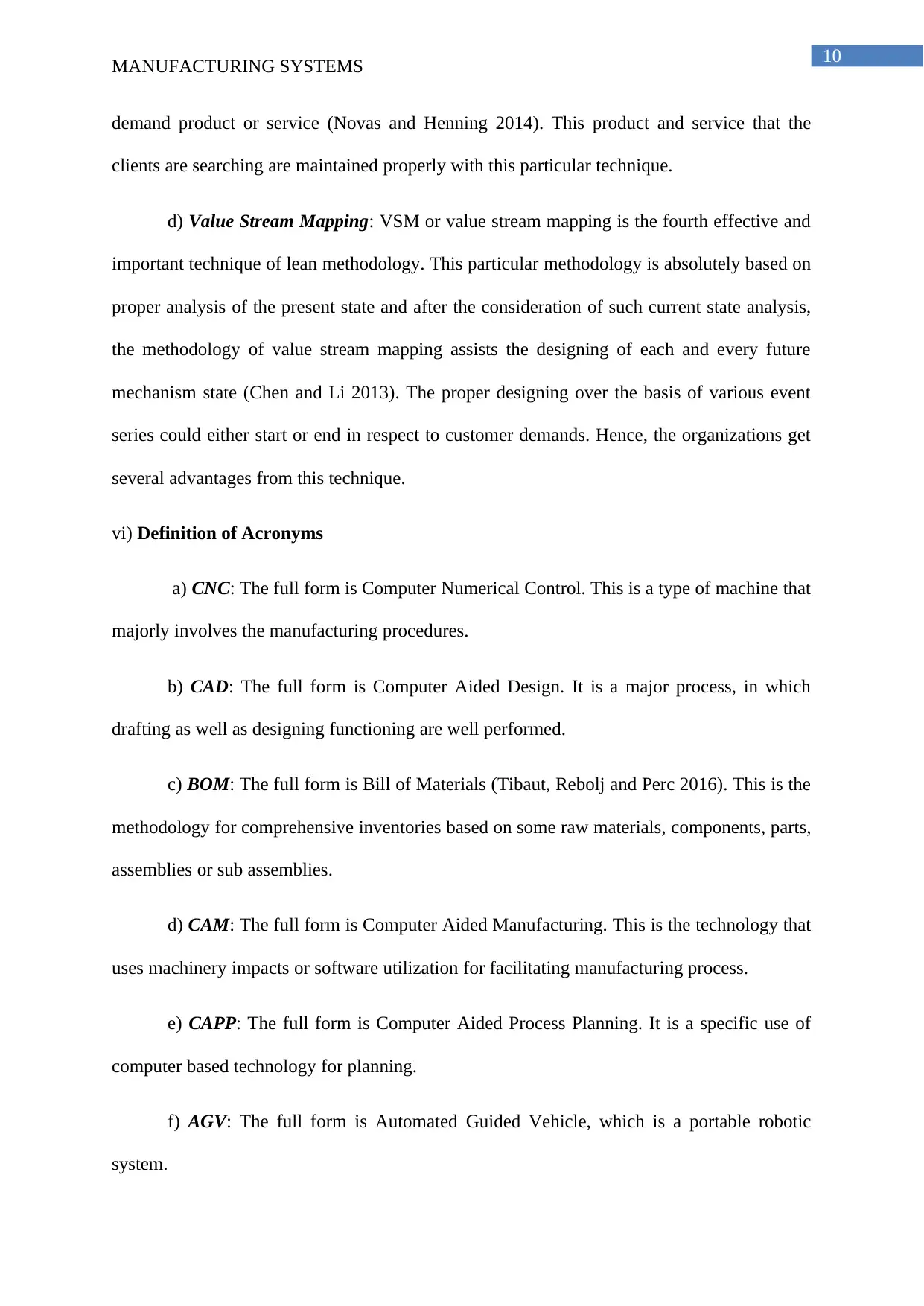
10
MANUFACTURING SYSTEMS
demand product or service (Novas and Henning 2014). This product and service that the
clients are searching are maintained properly with this particular technique.
d) Value Stream Mapping: VSM or value stream mapping is the fourth effective and
important technique of lean methodology. This particular methodology is absolutely based on
proper analysis of the present state and after the consideration of such current state analysis,
the methodology of value stream mapping assists the designing of each and every future
mechanism state (Chen and Li 2013). The proper designing over the basis of various event
series could either start or end in respect to customer demands. Hence, the organizations get
several advantages from this technique.
vi) Definition of Acronyms
a) CNC: The full form is Computer Numerical Control. This is a type of machine that
majorly involves the manufacturing procedures.
b) CAD: The full form is Computer Aided Design. It is a major process, in which
drafting as well as designing functioning are well performed.
c) BOM: The full form is Bill of Materials (Tibaut, Rebolj and Perc 2016). This is the
methodology for comprehensive inventories based on some raw materials, components, parts,
assemblies or sub assemblies.
d) CAM: The full form is Computer Aided Manufacturing. This is the technology that
uses machinery impacts or software utilization for facilitating manufacturing process.
e) CAPP: The full form is Computer Aided Process Planning. It is a specific use of
computer based technology for planning.
f) AGV: The full form is Automated Guided Vehicle, which is a portable robotic
system.
MANUFACTURING SYSTEMS
demand product or service (Novas and Henning 2014). This product and service that the
clients are searching are maintained properly with this particular technique.
d) Value Stream Mapping: VSM or value stream mapping is the fourth effective and
important technique of lean methodology. This particular methodology is absolutely based on
proper analysis of the present state and after the consideration of such current state analysis,
the methodology of value stream mapping assists the designing of each and every future
mechanism state (Chen and Li 2013). The proper designing over the basis of various event
series could either start or end in respect to customer demands. Hence, the organizations get
several advantages from this technique.
vi) Definition of Acronyms
a) CNC: The full form is Computer Numerical Control. This is a type of machine that
majorly involves the manufacturing procedures.
b) CAD: The full form is Computer Aided Design. It is a major process, in which
drafting as well as designing functioning are well performed.
c) BOM: The full form is Bill of Materials (Tibaut, Rebolj and Perc 2016). This is the
methodology for comprehensive inventories based on some raw materials, components, parts,
assemblies or sub assemblies.
d) CAM: The full form is Computer Aided Manufacturing. This is the technology that
uses machinery impacts or software utilization for facilitating manufacturing process.
e) CAPP: The full form is Computer Aided Process Planning. It is a specific use of
computer based technology for planning.
f) AGV: The full form is Automated Guided Vehicle, which is a portable robotic
system.
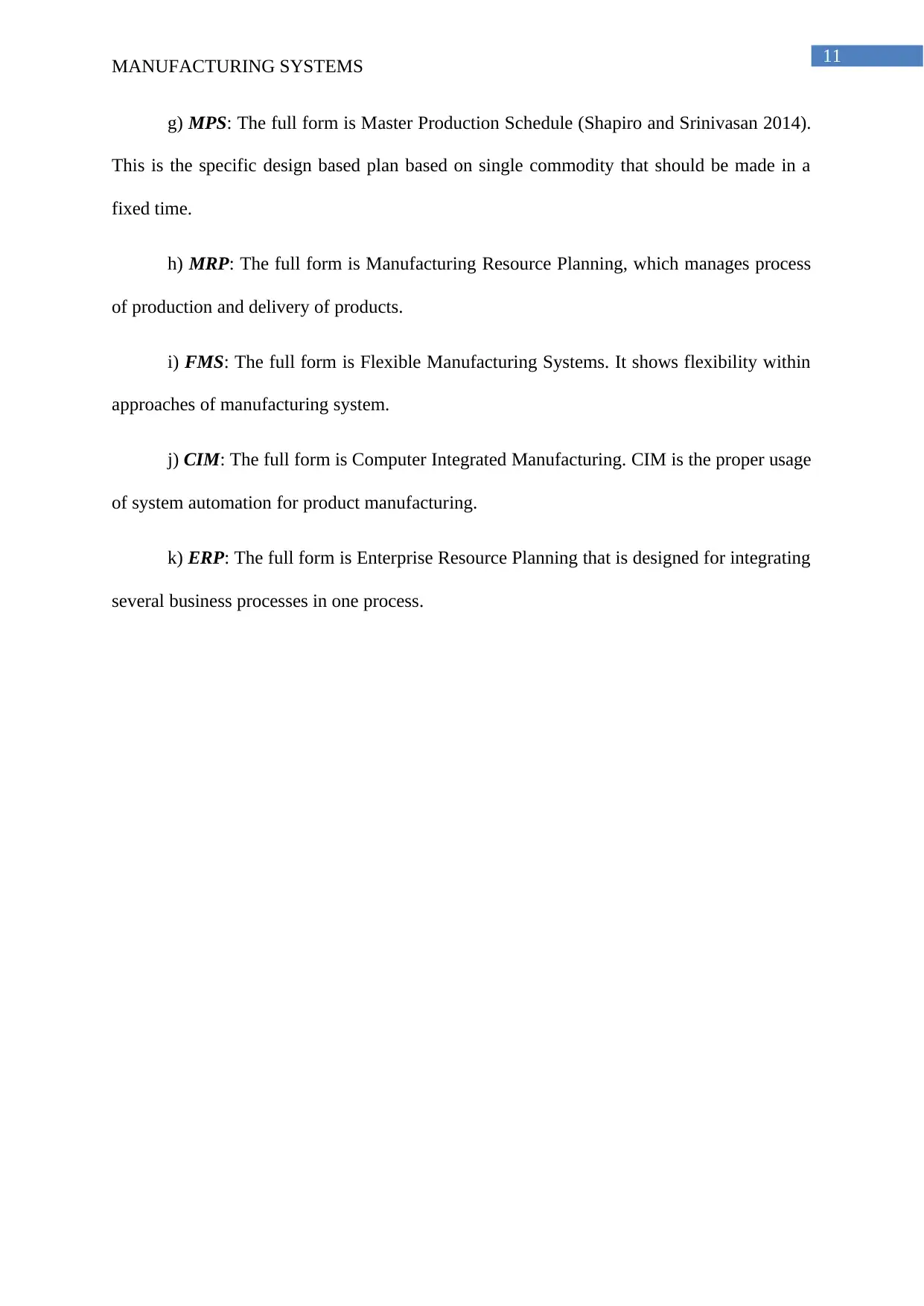
11
MANUFACTURING SYSTEMS
g) MPS: The full form is Master Production Schedule (Shapiro and Srinivasan 2014).
This is the specific design based plan based on single commodity that should be made in a
fixed time.
h) MRP: The full form is Manufacturing Resource Planning, which manages process
of production and delivery of products.
i) FMS: The full form is Flexible Manufacturing Systems. It shows flexibility within
approaches of manufacturing system.
j) CIM: The full form is Computer Integrated Manufacturing. CIM is the proper usage
of system automation for product manufacturing.
k) ERP: The full form is Enterprise Resource Planning that is designed for integrating
several business processes in one process.
MANUFACTURING SYSTEMS
g) MPS: The full form is Master Production Schedule (Shapiro and Srinivasan 2014).
This is the specific design based plan based on single commodity that should be made in a
fixed time.
h) MRP: The full form is Manufacturing Resource Planning, which manages process
of production and delivery of products.
i) FMS: The full form is Flexible Manufacturing Systems. It shows flexibility within
approaches of manufacturing system.
j) CIM: The full form is Computer Integrated Manufacturing. CIM is the proper usage
of system automation for product manufacturing.
k) ERP: The full form is Enterprise Resource Planning that is designed for integrating
several business processes in one process.
⊘ This is a preview!⊘
Do you want full access?
Subscribe today to unlock all pages.

Trusted by 1+ million students worldwide
1 out of 22
Related Documents
Your All-in-One AI-Powered Toolkit for Academic Success.
+13062052269
info@desklib.com
Available 24*7 on WhatsApp / Email
![[object Object]](/_next/static/media/star-bottom.7253800d.svg)
Unlock your academic potential
Copyright © 2020–2025 A2Z Services. All Rights Reserved. Developed and managed by ZUCOL.




